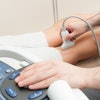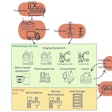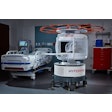SAN FRANCISCO - The selective estrogen receptor modulator (SERM) raloxifene (Evista, Eli Lilly) is associated with a reduced risk of invasive breast cancer, particularly among postmenopausal women with a family history of breast cancer, according to a presentation this week at the American College of Obstetrics and Gynecology (ACOG) meeting.
The findings will broaden doctors' options for treating osteoporosis, according to principal investigator Dr. Silvana Martino, an adjunct member of the medical oncology department at the John Wayne Cancer Institute in Santa Monica, CA. The women in the current research were all postmenopausal and had been diagnosed with osteoporosis.
The investigators conducted a secondary analysis of the data that are being compiled in the Continuing Outcomes Relevant to Evista (CORE) trial, which explored the drug's breast cancer risk, among other measures. They wanted to know the full extent of benefits linked to taking the SERM.
In CORE, a double-blind, placebo-controlled study, the investigators examined raloxifene's effects on the incidence of invasive breast cancer, and found that it was linked to a 59% lower rate compared to placebo. In the current research, a prespecified secondary analysis, the investigators compared the influence of raloxifene with placebo on the incidence of invasive breast cancer over an eight-year period when participants were stratified by family history of breast cancer.
The 4,011 women in the study had continued on from the Multiple Outcomes of Raloxifene Evaluation (MORE). Subjects who were taking 60 or 120 mg daily of raloxifene in MORE, took 60 mg daily in the CORE trial. Those in MORE's placebo arm continued to take placebo in the CORE study. The investigators defined patients as having a family history of breast cancer if the disease had occurred in a first-degree relative. This information was obtained at MORE's baseline and had involved 7,518 participants.
The investigators then analyzed the participants' time to the first diagnosis of invasive breast cancer. They found that, in the 949 patients with a family history, those taking raloxifene had a hazard ratio of 0.11 for invasive breast cancer, compared to those taking placebo. For the 6,569 women who did not have a family history of breast cancer, raloxifene was associated with a hazard ratio of 0.42.
Martino and her team concluded that raloxifene was linked to a lower incidence of invasive breast cancer in postmenopausal women with osteoporosis, whether or not they had a family history of breast cancer. However, the reduced risk was greater in those women who had no such history.
By Paula Moyer
AuntMinnie.com contributing writer
May 13, 2005
Related Reading
Drug for osteoporosis curtails knee arthritis, November 5, 2004
Raloxifene cuts breast cancer risk: 8-year data reported at ASCO, June 9, 2004
Copyright © 2005 AuntMinnie.com



















